More Than a Political Metaphor: Megaproject on Virginia’s I-66 Reduces D.C. Gridlock
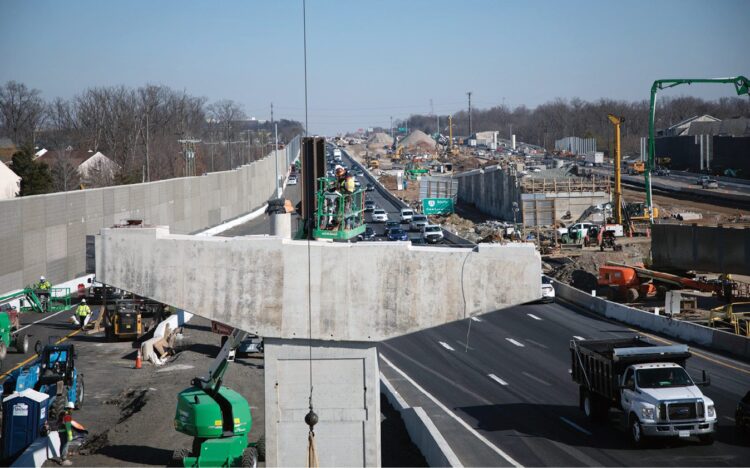
At any time during the construction seasons of 2021 and 2022, commuters might be traveling through 22.5 miles of continuous construction
In the Washington, D.C., metro area, “gridlock” is more than a political metaphor, it’s a daily fact of life for hundreds of thousands of commuters. The area has some of the worst (and most publicized) traffic congestion in the United States, with up to 200,000 vehicles on the roadway each day experiencing eight to 10 hours of daily congestion … just on the 76.38 miles of Virginia’s Interstate 66 (I-66).
It’s a well-studied fact that congestion doesn’t just exact a daily toll of hours of anxiety and boredom from the individual psyche, it also measurably costs civilizations (and individuals) money—lots of money. In reports such as “2022 Global Traffic Scorecard,” INRIX (a private company that provides location-based traffic data to agencies and businesses such as Google Waze and publishes research reports on traffic congestion) makes the following points:
• Traffic congestion occurs when demand for roadway travel exceeds the supply of roadways. As vehicular traffic builds, drivers, freight movers and bus riders lose time and spend fuel unproductively.
• In addition to lost time, negative externalities such as freight delay, inflationary pressure and environmental impact are generally exacerbated due to traffic congestion.
• Traffic is more detrimental to our wallets than our patience—in 2013, traffic congestion robbed the U.S. economy of $124 billion. Without significant action to alleviate congestion, this cost is expected to increase 50 percent to $186 billion by 2030.
• Americans will waste $2.8 trillion on traffic by 2030 if gridlock persists—the same amount Americans collectively paid in U.S. taxes in 2022.
In the context of hundreds of billion dollars annually and trillions per decade, not to mention the cumulative cost to the national psyche of aggravation and boredom, a project cost of billions to reduce congestion in our nation’s capital suddenly looks entirely reasonable, more like good governance and a prudent investment than a boondoggle.
And it helps make sense of the eye-popping numbers that come up early when one considers the “Transform 66 Outside the Beltway” Virginia Department of Transportation (VDOT) project, a dramatic transformation of 22.5 miles of I-66 feeding into the famous beltway that surrounds and virtually defines the federal government.
• Project Design-Build cost: an approximately $2.3 billion construction project—that’s just more than $100 million per project mile.
• Design-Build Contractor FAM Construction, a joint venture of Ferrovial Construction (a multi-national contractor with assets of about $9 billion in 2017 and builder of multiple megaprojects such as the M3 Motorway in Ireland) and Allan Myers (a merely gigantic firm of 2,000 employees and “the largest self-performing heavy civil contractor and materials provider in the Mid-Atlantic”).
• More than 400 local/regional subcontractors and suppliers during the construction phase.
• 3.1 million tons of asphalt (maximum laid in a month: 121,000 tons in June 2021; more than 1 million tons laid in 2021).
• 57 million pounds of steel.
And how will congestion be reduced?
• Four new express lanes (two lanes each direction) alongside three general-purpose lanes, with space in the median for future transit.
• Congestion-based tolls with HOV-3+ traveling toll-free.
• Interchange improvements including ramp-to-ramp connections (auxiliary lanes).
• Improved park-and-ride facilities with access to express lanes; 4,000-plus new park-and-ride spaces.
• Enhanced bus service and transportation demand management (TDM) strategies.
• Bicycle and pedestrian trail and improvements, including 11 miles of new trail parallel to I-66 as well as improved pedestrian facilities on new bridges over I-66 (18-plus miles of trail in total).
All these improvements merit closer examination, but first let’s look at the effects of COVID-19 on the project, a trillion-dollar wild card thrown in the pot just as construction really got going.
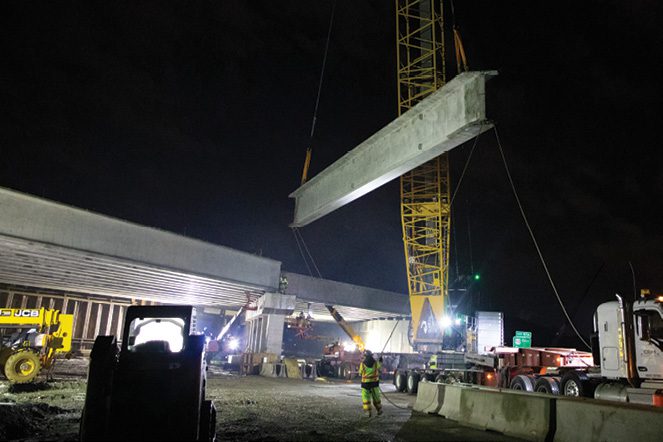
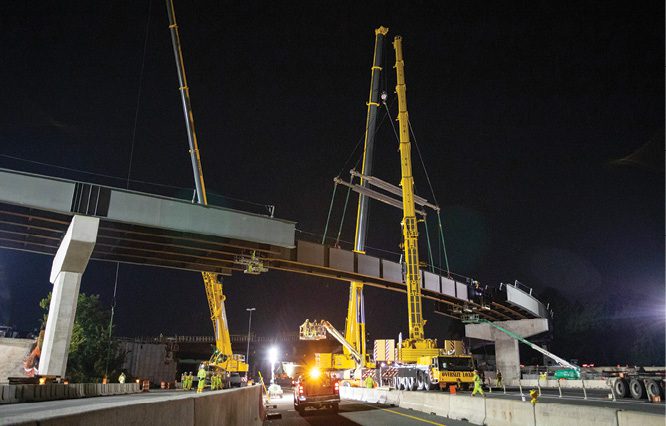
Photos show the setting of the largest concrete (top) as well as steel (bottom) beams of the I-66 project over I-495.
COVID-19 … and Record Productivity?
Some project construction began in 2019, and the biggest construction season was the summer of 2020, which means that a pandemic that began in November 2019 and led to lockdowns initiated on March 19, 2020, seemed eerily well timed to badly disrupt one of the biggest highway expansions ever attempted in Virginia.
“Certainly, the construction industry was impacted by COVID like every other industry, so we did have challenges with our workforce,” says VDOT Mega Projects Director and Design-Build Program Manager Susan Shaw. “And we had supply chain issues as well, particularly with steel production coming from states where there were restrictions and shutdowns of manufacturing. There were significant impacts on the supply chain side for steel beams and steel for gantries, signage, things like that, that we had to deal with—just as everyone else in the industry.”
This could have been disastrous; expanding I-66 and reducing congestion in a reasonable timeframe absolutely required superb and comprehensive coordination of massive amounts of labor, equipment and supplies.
“It was pretty much an around the clock, seven days a week type of project,” says FAM Corporate Affairs Director Nancy H. Smith. “Particularly during peak construction, we had three shifts of crews, six or seven days a week, depending on the activity. And a lot of work in the corridor involved bridge work over travel lanes—63 structures were either newly constructed or reconstructed—that mostly had to be done during the overnight hours.”
Nor was this a small-scale roadway reconstruction; VDOT plans called for a “perpetual pavement” system, which means I-66 was basically rebuilt from the base layer up, providing a smooth surface that should only require surface repaving for many years to come. So how did FAM stay under budget and within timelines during a pandemic?
Two factors helped mitigate the negative impacts of COVID on project success. “Here in Virginia, we were deemed an essential industry, so we were able to keep working,” says Shaw. “And while there were challenges with health and safety and needing to implement all kinds of regulations and safety measures to keep our employees safe with things that were rapidly changing, we were able to continue to work and provide jobs during a time when a lot of people were put off work.”
Strangely, lockdowns and stay-at-home orders had a generally positive effect on construction. “We did see huge traffic reductions due to COVID during the project, and we certainly took advantage of that,” explains Shaw. “For one thing, we had committed to keeping the existing four lanes open during peak times, but with the reduced traffic, we were able to back off that and go down to three lanes in critical segments. Reduced traffic made it easier to coordinate lane closures, so we weren’t sending people on multiple detours within the corridor.”
The upshot was FAM was able to achieve record productivity at some points during construction. “A few statistics really tell the story,” says Smith. “During peak period, which was the construction season of 2020 and 2021, we were seeing an average of 2,000 to 2,100 workers onsite any given day. And in summer 2020, we saw $293 million in production just during that summer construction season. Every month that summer was over $60 million in production, which tells you there was substantial construction going on. There were still lots of challenges to deal with, but we overcame those to keep focused on the project.”
Shaw agrees: “I have to say, despite the challenges, FAM really brought it and got the work done.”
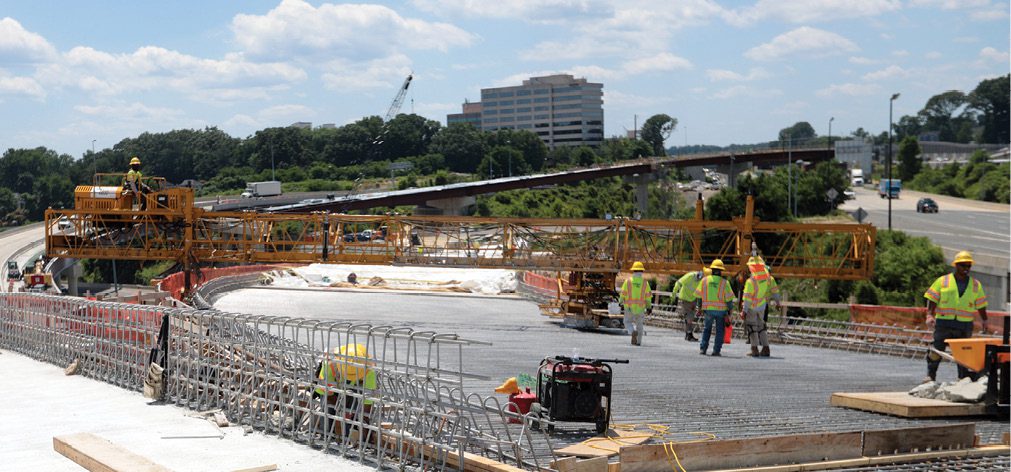
Bridge deck work is performed at the I-495 interchange.
Heavy Tolls and the Return of Slugging
The congestion-based toll lanes being installed on these 22 miles are not new in Virginia; they’ve been operational in some form on I-66 for decades. And it’s not a complicated idea; when the demand for roadway is high, raise the cost of roadway to dissuade drivers and reduce congestion.
But sometimes demand-based tolls rise to startling amounts. In 2017, there was substantial public and political pushback when tolls briefly peaked at $40 or more for a 10-mile section. But from VDOT’s point of-view, the heavy toll was successful and led to a 45-percent drop in average travel time along the 10-mile tollway stretch during morning commute hours.
“The toll is saying, ‘We don’t want you to use it.’ I personally wouldn’t pay that toll,” Virginia Transportation Secretary Aubrey Layne said at the time. “And no one has to—you can simply put another person in your car.”
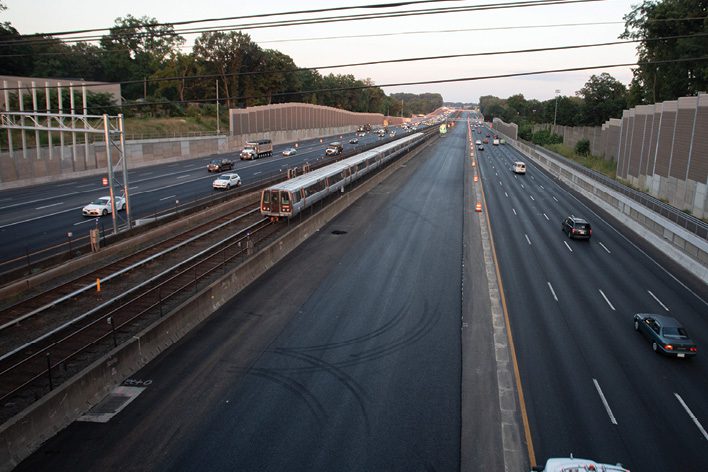
“HOV-3+ traveling toll-free” on these new lanes is self-explanatory; vehicles with three or more occupants will travel at higher speeds and pay nothing. It’s a strong financial and time-saving incentive to carpool that has led to a culture of casual ridesharing. Other cities have demand-based tolls, but through the decades, the practice in D.C. has taken on a formality that exceeds other regions, and a name, “slugging,” that seems to have originated here. Basically, ridesharing in D.C. is now a recognized subculture, with a dedicated website (slug-lines.com) and apps, and even amounts to a community of sorts.

Traffic signal gantry installations were a late-project challenge.
Per the VDOT website, slugging works like this:
A car needing additional passengers to meet the required three-person high-occupancy vehicle (HOV) minimum pulls up to one of the known slug lines.
The driver calls out the destination, such as “Pentagon,” “L’Enfant Plaza” or “14th and New York.”
The slugs first in line for that particular destination then hop into the car, and off they go.
Even with the established slugging subculture, VDOT recognized early that “limited carpool culture and transit options” were a fact of commuting life, and made carpooling and public transit a project priority. “An early milestone for us was, in fall 2019, delivery of park and ride lots, parking and bus service—even though nobody was riding buses at the height of COVID,” says Shaw. “But we knew that slugging—getting in cars with strangers, basically—was important, especially with the change from HOV-2 to HOV-3. And it’s been very rewarding to see that community return with people coming out of COVID.”
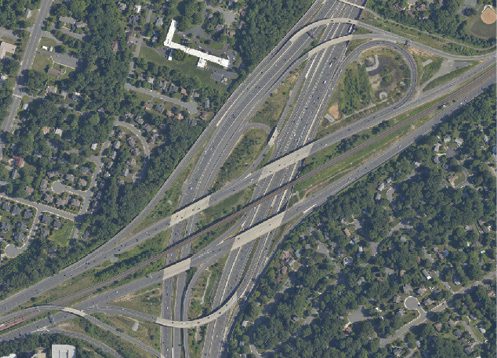
2018

2022
I-495 Interchange rebuilt with 11 new bridges, including the longest bridge of the project.
Megaprojects Within Megaprojects
Successfully implementing 2,100 workers and up to 300 pieces of heavy equipment along the entire project corridor required a divide-and-conquer strategy, which meant conceptually breaking up the 22.5-mile megaproject into smaller pieces.
“Given the tight timeframe, it wasn’t a project where we could start on one end and work our way to the other,” says Smith. “So we broke the project up into three segments and then various subsegments within each, basically creating three smaller megaprojects within a large megaproject, to help better manage all this construction happening at the same time. At any point in time from late 2018, when construction really began ramping up and into 2019, through this fall [2022], drivers were experiencing active construction throughout that 22-and-a-half miles as well as up the 28 corridor and other ancillary roads at the same time.” All this while keeping three or four lanes open for drivers.
Another way to break out multiple megaprojects from the overall megaproject is to consider the project’s many structures. A whopping 63 bridges and overpasses, and 12 interchanges were built or reconstructed, and at least three of the interchange reconstructions are sufficiently massive to qualify as megaprojects in their own right.
I-495 Interchange
“At the 495 interchange, we added 11 new bridges, including the longest bridge of the project, which is the new ramp from 495 North to I-66 West,” says Smith. And this was a crowded worksite, requiring coordination of multiple agencies. “It’s a little hard to make out in the [accompanying] photo, but the WMATA metro rail line runs right through the center of the interchange as well as another express lane system operated by another provider. So lots of coordination was needed here, not only with VDOT, but also that operator as well as WMATA, on top of adding 11 new bridges—just a lot of complexity here.”
Nutley Street Interchange
“At the time we built this interchange, cloverleafs were the standard design,” says Shaw. “But not now—the issue is the back-to-back loops and the weave merge that had to occur in the short distance between the loops—it leads to side-swipe accidents. Nutley Street itself is posted at 35 mph, so they’re not high-speed accidents, but this was the tightest cloverleaf with the most traffic moving through it in the United States, and there were a lot of accidents and traffic delays.” To improve access and safety, FAM entirely reconstructed the cloverleafs into double roundabouts. “We call it our ‘dog bone,’” adds Shaw. “The new configuration is a good example of the innovation that FAM brought to the table in this project.”
Route 28 Interchange
“The 28 interchange redesign is the other really impressive part of the project corridor,” explains Shaw. “It’s a similar interaction as the 495/I-66 interchange, but there are actually more bridges here—a total of 13 were part of this reconfiguration. It started as a simple single-level semi-cloverleaf, and it’s been rebuilt into a two-and-a-half-level interchange. And we reconnected two roads on either side of Route 28 that had previously been cut off from each other and provided a great separated crossing to reconnect those communities. Plus new access to I-66 in both directions as well as the new express lanes in both directions from here. So quite a lot of construction.”
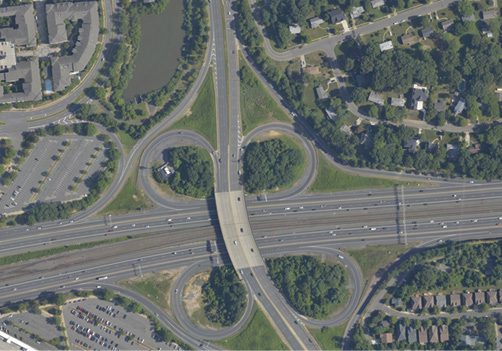
2018
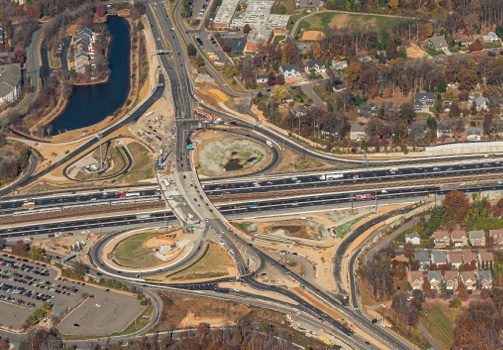
2022
Nutley Street Interchange in 2018, the tightest cloverleaf with the most traffic moving through it in the United States, was entirely reconstructed into double roundabouts.
Mega Challenges
Luis Vazquez, MBA, MSCE, is the CEO of I-66 Express Mobility Partners, the consortium of global infrastructure companies Cintra, Meridiam and APG that’s “contracted to design, build, finance, operate and maintain the $3.7 billion, 22.5-mile multi-modal Transform 66 Outside the Beltway megaproject known as the 66 Express Lanes, which achieved service commencement ahead of schedule.”
66 Express Lanes is possibly the largest public-private partnership (P3) infrastructure project in the United States this century. As CEO, Vazquez is perhaps the single person most aware of the difficulties involved in bringing a project of this magnitude to successful completion ahead of schedule.
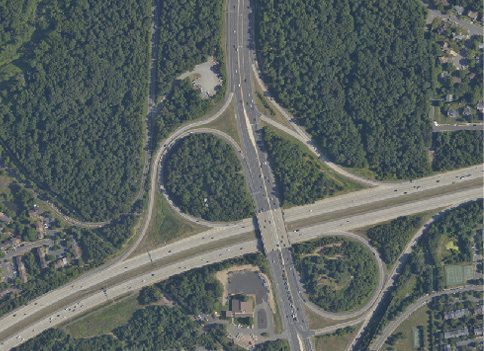
2018
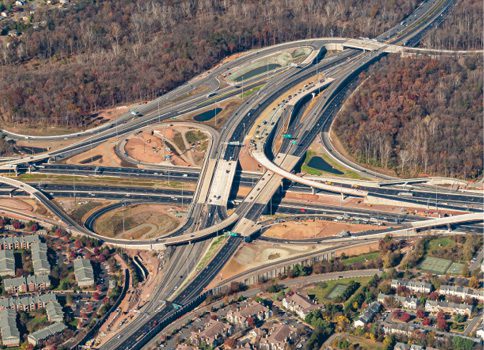
2022
The Route 28 Interchange single-level semi-cloverleaf was rebuilt as a two and a half level interchange with 13 new bridges.
“Apart from overcoming the amount of traffic management that had to be done, and the effects of the pandemic throughout, and the supply chain issues, the other main challenge was the coordination—in the late stages of the project—of the civil works with the tolling equipment that had to be deployed to open the express lanes,” notes Vazquez. “As you can imagine, there is a substantial amount of tolling equipment, in terms of gantries and additional infrastructure that provide information for the algorithm to make sure the level of service in the express lanes is maintained according to the contract. That was another challenge overcome by all the partners, in coordination with the construction team.
“Thanks to VDOT’s leadership and innovation they put in place in the contract, the project was able to open ahead of time and meet all requirements,” he adds. “[This] is another benefit from the P3 scheme VDOT put in place, because it encourages all parties in the consortium to make sure they put all their efforts to make sure all contractual milestones are met.
“This project is now part of a network for transportation in Northern Virginia that will improve the quality of life of all commuters in this area. Hopefully, we stand up to the challenges and deliver during the operations phase, with the partnership with VDOT and all our stakeholders,” says Vazquez.
About Angus Stocking
Angus Stocking is a former licensed land surveyor who has been writing about infrastructure since 2002 and is the producer and host of “Everything is Somewhere,” a podcast covering geospatial topics. Articles have appeared in most major industry trade journals, including CE News, The American Surveyor, Public Works, Roads & Bridges, US Water News, and several dozen more.


